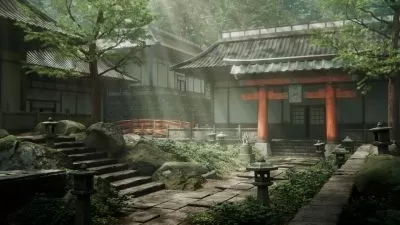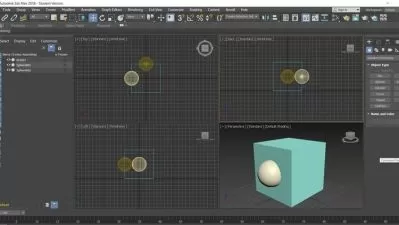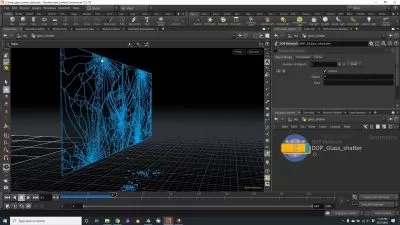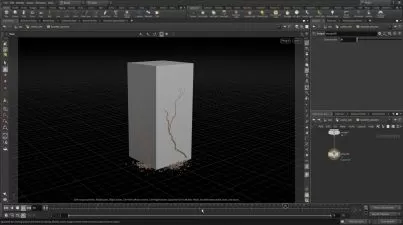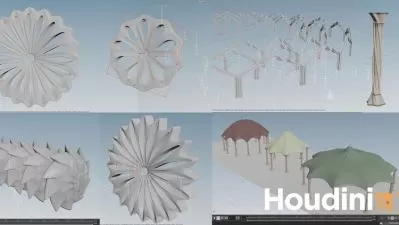Houdini The Geometry Essentials Collection
Focused View
20:40:26
48 View
01. Creating Primitive Geometry - Create at object level vs create in context.mp4
02:45
02. Creating Primitive Geometry Objects - Viewport Handles.mp4
02:14
03. Geometry Components Part 01 - Points, Edges, and Primitives.mp4
09:11
04. Geometry Components Part 02 - Vertices.mp4
06:56
05. Component Numbers.mp4
06:23
06. Connecting Points - Curves.mp4
08:24
07. Disconnecting and Reconnecting Points.mp4
08:41
08. Vertices Control Connectivity.mp4
08:05
09. Connecting Points - Particles to Surfaces.mp4
05:22
10. Closed Curves are also Polygon Surfaces.mp4
06:28
11. Every Polygon Face is also a Closed Curve.mp4
08:25
12. Drawing and Editing Polygons Using the Curve SOP - Part 1.mp4
06:39
13. Drawing and Editing Polygons Using the Curve SOP - Part 2.mp4
06:58
14. Drawing and Editing Polygons Using the Curve SOP - Part 3.mp4
04:43
15. Open and Closed Polygons - Part 1 - The Ends SOP.mp4
04:13
16. Open and Closed Polygons - Part 2 - The Crucial Role of Vertices.mp4
06:16
17. Open and Closed Polygons - Part 3 - Rendering Curves.mp4
05:54
18. Open and Closed Polygons - Part 4 - Rendering Wireframe Geometry.mp4
06:50
19. Polymodelling Tools on Polygon Curves.mp4
07:45
20. Polygon options on Primitive Object Nodes.mp4
06:52
21. Drawing Bezier Curves.mp4
05:34
22. Editing Bezier Curves - Points and Tangency.mp4
04:33
23. Editing Bezier Curves - Segments.mp4
05:46
24. Editing Bezier Curves - Rounded Corners.mp4
04:07
25. Working with Bezier Curves - Reference Images.mp4
03:42
26. Working with Bezier Curves - Tracing a Profile.mp4
04:41
27. Working with Bezier Curves - Modelling.mp4
05:53
28. Working with Bezier Curves - Resampling Bezier Curves to Polygons.mp4
04:36
29. Optimising Curves with the Refine SOP.mp4
03:58
30. How Bezier Curves work - Order and Degree.mp4
09:06
31. How Bezier Curves work - Components.mp4
09:01
32. Editing Bezier Curves - Curve SOP vs Edit SOP.mp4
07:16
33. Editing Bezier Curves - Procedural Nodes vs Non-Procedural Nodes.mp4
04:27
34. Editing Curves Procedurally.mp4
07:45
35. Animating Curves.mp4
07:55
36. Comparing Nurbs Curves to Bezier Curves.mp4
07:11
37. Nurbs Curves - Order - Part 1.mp4
05:10
38. Nurbs Curves - Order - Part 2.mp4
06:02
39. Drawing and Editing Nurbs Curves Using the Curve Node.mp4
06:03
40. Nurbs Curves - Point Weight.mp4
05:49
41. Auto Bezier Draw Mode.mp4
07:47
42. Generating Nurbs and Bezier Curves Procedurally - The Fit Node.mp4
06:40
43. Parametric Space.mp4
06:22
44. Parameterisation - Part 1 - Uniform vs Chord Length.mp4
03:47
45. Parameterisation - Part 2 - Chord Length and Centripetal.mp4
04:02
46. Nurbs and Bezier Surfaces - Part 1 - Cross Section Curves.mp4
06:16
47. Nurbs and Bezier Surfaces - Part 2 - Parametric Space.mp4
07:09
48. Comparing Nurbs and Bezier Curves to Polygon Curves.mp4
07:49
49. Using Polygon Curves Like Nurbs Curves - Subdivision Curves.mp4
07:13
50. Interpolating Curves - Nurbs and Beziers vs Polygons.mp4
08:04
51. Converting Polygon Faces to Nurbs Surfaces.mp4
07:00
52. Bilinear Mesh.mp4
06:03
53. Polygon Soups Part 01 - Memory and Disk Space.mp4
09:52
54. Polygon Soups Part 02 - Benefits and Limitations.mp4
05:03
55. Quadratic Primitives.mp4
05:33
01. What Are Attributes.mp4
06:20
02. An Analogy For Attributes.mp4
05:03
03. The Position Attribute and the Geometry Spreadsheet.mp4
04:54
04. Attribute Class.mp4
08:10
05. Creating and Manipulating Attributes.mp4
08:39
06. Attribute Types.mp4
07:30
07. Attribute Create Node.mp4
04:28
08. Attribute Type Qualifier - Attribute Meaning.mp4
10:26
09. What Are Normals.mp4
03:43
10. Calculating and Adding Vertex Normals.mp4
06:16
11. Normal Weighting Methods.mp4
04:31
12. Creating Attribute Visualisers.mp4
05:04
13. Remapping Values and Per Component Ramps.mp4
05:41
14. Using Colour to Visualise Normal Interpolation Across Primitives.mp4
04:31
15. Adding The Normal Attribute vs Auto Generate.mp4
04:15
16. Attribute Mismatch.mp4
04:24
17. Default Attribute Values.mp4
03:21
18. Drawing Vectors.mp4
04:08
19. Vector Visualisation - Markers.mp4
04:27
20. Unit Vectors.mp4
05:33
21. Unit Vectors Part 02.mp4
04:39
22. The Copy To Points Node.mp4
06:27
23. Using Normals to Orientate Geometry.mp4
05:27
24. Adding Randomisation to Attributes.mp4
04:39
25. Attribute Randomise - Visualising the Distribution.mp4
03:46
26. Polygon Winding Order.mp4
04:56
27. Reversing Vertex Order Using the Reverse Node.mp4
05:52
28. Shifting the Vertex Order.mp4
04:33
29. Reversing Vertex Order Vs Reversing Normals - Part 01.mp4
04:14
30. Reversing Vertex Order Vs Reversing Normals - Part 02.mp4
06:08
31. Correcting Primitive Normals.mp4
02:36
01. Global Variables as Shorthand for Constant Values.mp4
07:57
02. Global Variables - A Constant Name for Changing Values.mp4
04:41
03 - Attributes, Variables And Parameters.zip
03. Local Variables.mp4
06:17
04. Global And Local Variables in the Output Context.mp4
07:02
05. Local Variables Take Precedence Over Global Variables.mp4
03:18
06. What exactly is the Bounding Box.mp4
06:00
07. Min and Max Local Variables on the Transform Node.mp4
04:24
08. Transform Local Variables and the Match Size Node.mp4
06:17
09. Using Attributes and Local Variables in Parameter Expressions.mp4
08:50
10. Relative Bounding Box Using Local Variables.mp4
09:38
11. Project And System Overview.mp4
05:25
12. Channel References.mp4
04:18
13. HScript Bounding Box Expression.mp4
06:23
14. The Advantage of Referencing Nulls.mp4
03:56
15. Importance of Positioning Geometry.mp4
05:56
16. Aligning with the Origin.mp4
04:05
17. Organising The Network.mp4
03:30
18. Copying to First and Last Points.mp4
04:43
19. Using Polyframe to Orientate the Copied Geometry.mp4
01:41
19. Using Polyframe to Orientate the Copied Geometry 1.mp4
06:10
20. Orientation Along Curve and the Order of Operations.mp4
05:46
21. Understanding the Up Vector.mp4
05:09
22. Computing and Controlling the Up Vector.mp4
05:40
23. Leveraging the Primary and Secondary Axis.mp4
05:16
24. Manipulating the Normal Attribute.mp4
05:30
25. Controlling Distribution Using the Resample Length.mp4
05:28
26. Tangent Type and Arc Length vs Chord Length Measurement Method.mp4
04:30
27. Justifying the Copy on the First Point.mp4
06:38
28. Justifying the Copy on the Last Point.mp4
03:17
29. Resampling the Planar Curve.mp4
06:24
30. Using the Ray Node to Deal with Elevation.mp4
06:39
31. Resampling Twice for Greater Precision.mp4
04:10
32. Raying Back onto the Input Curve.mp4
04:01
33. Ray Tolerance and Treating Polygons as Straight Edges.mp4
04:45
34. Maintaining the Last Vertex.mp4
04:31
35. Adding Spare Parameters to Nodes.mp4
06:31
36. Resampling by Polygon Edge.mp4
03:44
37. Adding Normals and Handling Attribute Mismatches.mp4
04:17
38. Randomising Scale and Position.mp4
06:46
39. Randomising Orientation.mp4
02:40
40. Environment Layout Tasks And Object Merge.mp4
07:06
41. Creating Curves from Edge Selections And the Output Node.mp4
05:00
42. Resample - Arc Length and Even Last Segment.mp4
05:46
43. Creating a Post And Rail Fence.mp4
03:53
44. Using the Sweep Node to Add the Rails.mp4
05:37
45. Using Normal And Up Attributes with the Sweep Node.mp4
05:02
46. Offsetting the Curve using the Poly Extrude Node.mp4
03:31
47. Poly Extrude - Extrude Along Edge Normal vs Front Transform.mp4
05:25
48. Using the Carve Node to Shorten the Curve.mp4
02:32
49. Using the Stacking System to Build Street Lamps.mp4
05:38
50. Distributing the Street Lamps.mp4
04:34
01. Using @attribute Notation Within Parameters.mp4
07:02
02. @attibute on Newer Nodes and in Group Parameter Fields.mp4
04:27
03. Accessing Detail Attributes Using an Expression Function.mp4
05:57
04. Using an Expression Function to Access Primitive Attributes.mp4
07:39
05. The Benefit of Using Relative Paths.mp4
04:04
06. When its Better to Use Absolute Paths.mp4
03:55
07. Creating the Geometry.mp4
04:07
08. Calculating the Circumference Using the Measure Node.mp4
04:24
09. Creating the Rotation to Linear Motion Expression.mp4
03:31
10. Deforming the Sheet Around the Roller.mp4
03:19
11. Testing and Animating The Setup.mp4
04:45
12. Generating Distance and Mask Attributes.mp4
03:49
13. Transforming Points by Attribute Value.mp4
07:04
14. Animating the Attribute Values.mp4
03:18
15. Using a Ramp Parameter to Remap Attribute Values.mp4
06:18
16. Extruding Primitives by Attribute Value.mp4
06:55
17. Using the Resample Node to Generate a CurveU Attribute.mp4
03:56
18. Bevelling Edges by Attribute Value.mp4
04:02
19. Modifying Attribute Values Using the Attribute Adjust Node.mp4
05:03
20. Reviewing the Workflow of Generating, Modifying and Using Attributes.mp4
07:23
Project Files.zip
01. VEX Performance Comparison Setup.mp4
04:05
02. Using the Performance Monitor.mp4
05:32
03. Explaining the Results.mp4
05:06
04. Running Over Geometry Components.mp4
04:48
05. The Position Variable.mp4
03:50
06. Attribute Inputs And Outputs and Data Type Colours.mp4
08:03
07. Time Global Variables and Converting from Float to Vector.mp4
05:37
08. Displacing Points Using a Texture Map.mp4
05:12
09. Isolating Colour Components and Computing Luminance.mp4
02:02
10. Retiming Attribute Values Using the Retime Node.mp4
03:01
11. Scaling Values Over Time.mp4
03:14
12. Clamping Values and Deleting Attributes.mp4
04:22
13. Visualising Attributes in VOPs.mp4
06:05
14. Using Velocity to Orientate Copies.mp4
02:50
15. Fitting Values to a New Range.mp4
04:44
16. Normalising Vectors And Computing Vector Length.mp4
04:15
17. Binding Attributes Part 01.mp4
03:02
18. Binding Attributes Part 02 - Exporting.mp4
05:59
19. Indexing Variables Part 1 - ptnum, primnum, vtxnum.mp4
03:56
20. Indexing Variables Part 2 - numpt, numprim, numvxt.mp4
03:19
21. Adding Polygons by Point Attribute.mp4
04:27
22. Selecting and Splitting Geometry by Attribute.mp4
06:27
23. Using Point Index to Generate a Curve U Coordinate.mp4
06:43
24. A Benefit of Working With Normalised 0-1 Values.mp4
03:15
25. Scaling Using the Match Size Node.mp4
04:03
26. Scaling to a Given Size Using the Transform Node.mp4
04:25
27. Point Sorting.mp4
05:20
28. Working With the Vertex Index.mp4
04:52
29. Using the Path Deform Node to Move Geometry Along a Curve.mp4
03:07
30. Measuring Curvature.mp4
04:40
31. Blending Vectors in VOPs.mp4
05:13
32. When and Why to use Parameter VOPs.mp4
04:43
33. Animating VOP Parameters.mp4
02:54
34. Naming, Labelling and Setting Parameter Defaults.mp4
02:52
35. The Importance of Naming Parameters.mp4
03:38
36. The Displace Along Normal VOP.mp4
07:09
37. The Relative to Bounding Box VOP.mp4
02:31
38. The Ramp Parameter VOP.mp4
04:58
39. An Introduction to Noise.mp4
05:37
40. Promoting and Referencing VOP Parameters.mp4
05:45
41. Noise - Frequency and Offset.mp4
03:41
42. Noise - Fractal Parameters.mp4
05:01
43. Noise - Fractal Types.mp4
03:47
44. Noise - Remapping And Correcting the Output.mp4
06:42
Project Files.zip
01. Graphing the Outputs.mp4
05:04
02. Relationships and Trends.mp4
05:45
03. The Organic Nature of Noise.mp4
04:11
04. Comparing the Distribution Ranges.mp4
04:55
05. Exercise Intro And Scattering Points.mp4
02:36
06. Running Over Numbers And the Clumping Nature of the Random Function.mp4
06:08
07. Point Relaxing.mp4
07:02
08. Working with Point Density.mp4
04:08
09. Controlling Point Density with Attributes.mp4
04:51
10. Geometry Resolution and Attributes.mp4
05:46
11. Comparing Attribute Values to Pixel Values.mp4
05:35
12. Correcting the Noise Output - Colour Correct And Levels.mp4
04:47
13. Correcting The Noise Output - Curves And Ramps.mp4
05:40
14. Compositing Attributes.mp4
05:47
15. Working with the Mask Controls.mp4
06:15
16. Replacing an Attribute VOP.mp4
04:55
17. Houdini as a Framework for Creating 3D Tools.mp4
03:52
18. Using Noise to Control Size.mp4
07:35
19. Randomising the Scale Attribute in VOPs.mp4
05:21
20. Controlling Random Distribution Using Bias And Gain.mp4
04:05
21. Graphing the Bias And Gain Controls.mp4
04:55
22. Controlling Random Distribution Using a Ramp Parameter.mp4
06:15
23. Comparing the Custom Built SOP to the Attribute Randomise SOP.mp4
05:39
24. Scattering Points.mp4
05:43
25. Randomising Rotation.mp4
02:53
26. The Orient Attribute.mp4
05:09
27. Adding Attributes to Existing Point Clouds.mp4
04:52
28. Distributing on Different Terrains And Objects.mp4
05:45
29. Optimising the System - Order of Operations.mp4
04:33
30. Optimising the System - Region of Interest.mp4
06:42
31. Summary.mp4
04:35
Project Files.zip
More details
User Reviews
Rating
average 0
Focused display
Category
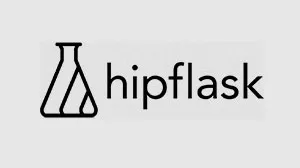
Hipflask
View courses HipflaskFraser Shiers is an award-winning creative director, 3D artist and university lecturer. He’s produced work for some of the world’s best known brands and advertising agencies, and has taught thousands of students how to get up and running with Houdini.
- language english
- Training sessions 232
- duration 20:40:26
- Release Date 2023/12/15








